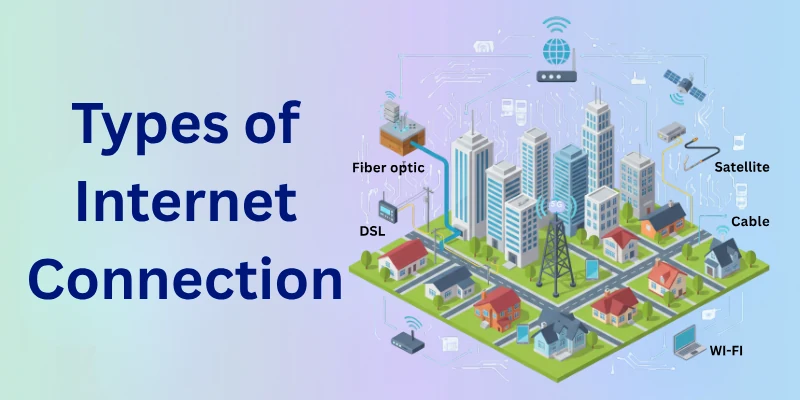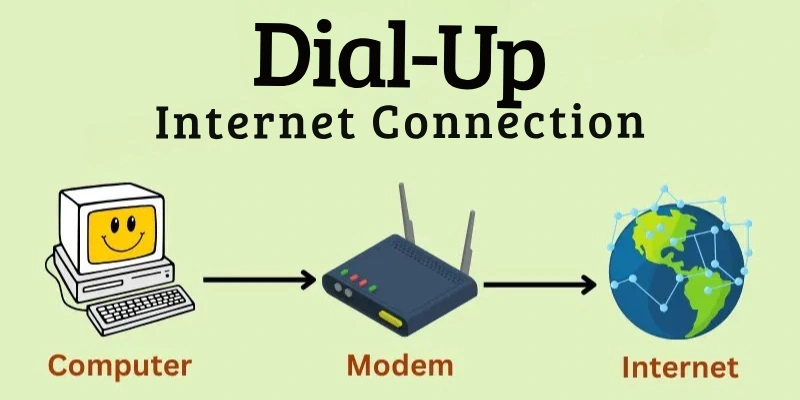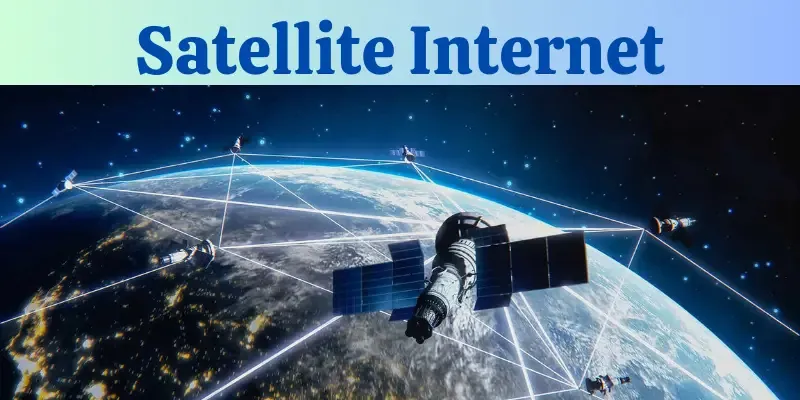Types of Internet Connection: Definition, Working, Pros & Cons
Published: 20 Aug 2025
In today’s digital age, the internet is an essential part of our daily lives, connecting people across the globe instantly.
As we explore the vast world of the internet, it is critical to grasp the various kinds of internet services available. Whether you’re streaming your favorite shows, sending emails, or perusing social media, the internet speeds and accessibility might vary dramatically.
So, let’s begin exploring the various types of internet connection and what each one offers!
Types of Internet Connection
In today’s digital age, there are various ways to connect to the internet, each with its own advantages and drawbacks.

Understanding the different types of internet connections, from dial-up to fiber-optic, is essential for effectively navigating the online world.
Here is a list of all internet connections:
- DSL (Digital Subscriber Line)
- Dial-Up Internet
- Cable Internet
- Fiber Optic Internet
- Satellite Internet
- Wireless Internet (Wi-Fi, Cellular Data)
So, guys, let’s explore the basics together!
1. DSL (Digital Subscriber Line)
DSL, or Digital Subscriber Line, is a technology that provides high-speed internet access over traditional copper telephone lines. It emerged in the late 1990s as an advancement over dial-up internet, offering faster speeds and an “always-on” connection.
How it Works and its Limitations
- Connection Process: DSL utilizes existing copper telephone lines but separates the voice and data signals, allowing for simultaneous internet access and telephone usage.
- Speed: DSL speeds vary depending on factors like distance from the ISP’s central office and the quality of the copper lines. Speeds can range from a few Mbps (megabits per second) to over 100 Mbps with newer technologies like VDSL.
- Limitations: DSL speeds degrade significantly with distance from the ISP’s central office, so users farther away may experience slower connections. Additionally, DSL infrastructure upgrades may be costly and time-consuming.
Pros of DSL
- Faster and more reliable than dial-up internet.
- Simultaneous use of internet and telephone services.
- Widely available in both urban and rural areas.
Cons of DSL
- Speeds may be limited by distance from the ISP’s central office.
- Performance can be affected by the quality of existing copper lines.
- Bandwidth may be shared with neighboring users, leading to reduced speeds during peak usage times.
Current Relevance and Usage
DSL remains a widely used form of internet access, especially in areas where fiber optic or cable infrastructure is not available. However, its popularity has declined in favor of faster technologies like cable and fiber optics.
2. Dial-Up Internet
Dial-Up Internet is a method of connecting to the internet using a standard telephone line and a modem. It gained popularity in the 1990s and early 2000s as one of the earliest forms of internet access for consumers. Users would dial a specific phone number provided by their internet service provider (ISP) using a modem, which would establish a connection to the ISP’s network.

How it Works and its Limitations
- Connection Process: When a user initiates a dial-up connection, the modem dials the ISP’s access number, establishes a handshake protocol, and then data is transmitted over the phone line.
- Speed: Dial-up internet speeds are typically very slow, with maximum speeds of 56 Kbps (kilobits per second) due to limitations in analog telephone lines.
- Limitations: It ties up the phone line while in use, making it impractical for voice calls simultaneously. Additionally, the slow speeds make it unsuitable for bandwidth-intensive activities like streaming media or online gaming.
Pros of Dial-up Internet
- Widely available, especially in rural areas where broadband options might be limited.
- Generally affordable compared to other forms of internet access.
- Relatively simple setup process.
Cons of Dial-up Internet
- Extremely slow speeds compared to modern broadband options.
- Incompatibility with voice calls while in use.
- Limited support for multimedia content or bandwidth-intensive applications.
Current Relevance and Usage
Dial-up internet has largely become obsolete in most developed regions due to the prevalence of broadband technologies like DSL, cable, and fiber optics. However, it may still have niche applications in areas where broadband infrastructure is lacking or for backup internet access.
3. Cable Internet
Cable Internet utilizes the same coaxial cable infrastructure as cable television to provide high-speed internet access. It emerged in the late 1990s as a faster alternative to dial-up and DSL connections.
How it Works and its Limitations
- Connection Process: Cable internet works by transmitting data over the same coaxial cables used for cable TV. A cable modem at the user’s premises connects to the cable network via a coaxial cable.
- Speed: Cable internet can offer significantly faster speeds compared to DSL, often ranging from 25 Mbps to over 1 Gbps (gigabit per second) depending on the service provider and infrastructure.
- Limitations: Cable internet speeds may degrade during peak usage times due to shared bandwidth among users in the same neighborhood. Additionally, the quality of service may vary depending on the cable infrastructure in a particular area.
Pros of Cable Internet
- Generally faster speeds compared to DSL.
- Available in many urban and suburban areas.
- Doesn’t tie up phone lines like dial-up or DSL.
Cons of Cable Internet
- Speeds may degrade during peak usage times.
- Limited availability in rural or remote areas.
- Service quality can be affected by the cable infrastructure’s condition and maintenance.
Current Relevance and Usage
Cable internet remains a popular choice for high-speed internet access in urban and suburban areas. Despite competition from fiber optic services, cable internet continues to offer competitive speeds and widespread availability in many regions. However, as fiber optic infrastructure expands, cable internet’s dominance may diminish in the future.
4. Fiber Optic Internet
Fiber optic internet utilizes thin strands of glass or plastic fibers to transmit data as pulses of light. Emerging in the late 20th century, it has become a dominant player in high-speed internet due to its exceptional performance.
How it Works and its Limitations
- Connection Process: Data is transmitted via pulses of light through bundled fiber optic cables. These cables ensure minimal signal loss over long distances.
- Speed: Offering some of the fastest speeds, ranging from 100 Mbps to over 1 Gbps, fiber provides low latency, making it ideal for activities like online gaming and streaming.
- Limitations: Deployment can be costly and time-consuming, particularly in rural areas. Physical damage to cables can disrupt service.
Pros of Fiber Optic Internet
- Exceptionally fast and reliable.
- Low latency enhances performance.
- Immune to electromagnetic interference.
Cons of Fiber Optic Internet
- Costly infrastructure deployment.
- Limited availability in some regions.
- Vulnerable to physical damage.
Current Relevance and Usage
Fiber optic internet is increasingly common in urban areas where high-speed internet demand is high. Many providers invest in fiber infrastructure to meet growing consumer expectations.
5. Satellite Internet
Satellite internet is a type of internet connection that utilizes satellites in Earth’s orbit to facilitate data transmission between the user’s satellite dish and the internet service provider’s (ISP) network. It emerged commercially in the late 1990s as a solution to provide internet access to remote or underserved areas where traditional wired infrastructure was not feasible.

How it Works and its Limitations
- Connection Process: Satellite internet works by establishing a connection between the user’s satellite dish and a satellite in geostationary orbit. Data is transmitted from the user’s computer to the satellite dish, which then communicates with the satellite in orbit. The satellite relays the data to the ISP’s ground station, which is connected to the internet backbone.
- Speed: Satellite internet speeds have improved over the years but are generally slower compared to other types of broadband internet. Typical speeds range from 12 Mbps to 100 Mbps, depending on the service provider and the specific satellite technology used.
- Limitations: One of the main limitations of satellite internet is latency, which refers to the time it takes for data to travel from the user’s computer to the satellite and back to the ground station.
Pros of Satellite Internet
- Provides internet access in remote.
- Relatively quick to deploy.
- Offers a viable alternative for users who have limited options for high-speed internet.
Cons of Satellite Internet
- Higher latency compared to other types of internet connections.
- Slower speeds and limited bandwidth.
- Susceptible to weather-related interference, such as rain fade.
Current Relevance and Usage
Satellite internet remains a crucial option for individuals and businesses in remote or rural areas where traditional wired internet infrastructure is unavailable or impractical. With advancements in satellite technology and the deployment of low-earth orbit (LEO) satellite constellations, satellite internet providers are working to improve speeds, reduce latency, and expand coverage to reach more users worldwide.
6. Wireless Internet (Wi-Fi, Cellular Data)
Wireless internet refers to internet connectivity that is transmitted over the airwaves using radio frequency (RF) signals. It encompasses technologies like Wi-Fi and cellular data, which have become increasingly ubiquitous since the late 20th century.
How it Works and its Limitations
- Connection Process: Wi-Fi connects devices to a local wireless router or access point, allowing them to communicate with each other and access the internet. Cellular data relies on cellular towers to transmit data between devices and the internet.
- Speed: Wi-Fi speeds vary depending on the router and internet connection, with typical speeds ranging from a few megabits per second (Mbps) to over 1 gigabit per second (Gbps). Cellular data speeds also vary depending on network coverage and technology generation, ranging from 3G speeds of a few Mbps to 5G speeds of several hundred Mbps or more.
- Limitations: Wireless internet can be affected by factors such as signal interference, obstructions, and distance from the router or cellular tower. In densely populated areas, network congestion can lead to slower speeds and degraded performance.
Pros Of Wireless Internet
- Provides flexibility and mobility.
- Wi-Fi provide convenient access to the internet for multiple devices.
- Cellular data offers internet access on-the-go, even in areas without Wi-Fi coverage.
Cons of Wireless Internet
- Wireless signals can be affected by interference from other devices or environmental factors.
- Coverage may be limited in rural or remote areas.
- Speeds and performance may vary depending on network congestion.
Current Relevance and Usage
Wireless internet technologies like Wi-Fi and cellular data are essential for modern connectivity, enabling users to access the internet from a wide range of devices and locations. With the proliferation of smartphones, tablets, laptops, and IoT devices, wireless internet has become indispensable for both personal and professional use. Ongoing advancements in Wi-Fi standards and cellular technology continue to improve speeds, coverage, and reliability for wireless internet users worldwide.
How to Check Which Internet Connection You Have
Not sure which type of internet you’re using? Here are some easy ways to check:
- Check your modem or router – Look at the model name or label. It often says if it’s DSL, Cable, or Fiber.
- Ask your internet provider – Contact customer support or check your bill; it usually mentions the connection type.
- Look at the cables – Phone line cable → DSL, Coaxial (TV cable) → Cable Internet, Thin glass-like cable → Fiber.
- Check your device settings – On phones, it shows if you’re on Wi-Fi, 4G, or 5G.
- Run an online speed test – Speeds can sometimes hint at the type (e.g., very high speed usually means Fiber).
In short, the fastest way is to check your ISP bill or router details, as they clearly mention the internet type.
Conclusion
Guys, in this article we have explored various types of internet services, covering their definitions, functionalities, pros, cons, and upcoming trends. Internet service providers vary by region, offering users different options based on location. As technology advances, we can anticipate further innovations in connectivity, shaping the way we engage online. In making informed decisions, users can maximize the benefits of the digital era.
FAQs
Here are the most commonly asked questions related to different types of internet connections:
The main types of internet connections are broadband, dial-up, satellite, and wireless. Broadband includes DSL, cable, and fiber optic internet. Satellite internet works through signals from satellites, while wireless includes Wi-Fi and mobile data. Each type has different speed, cost, and availability depending on the location.
DSL internet uses telephone lines to connect you to the internet. Cable internet uses coaxial cables, the same type used for TV service. Cable internet usually offers faster speeds than DSL, especially for downloads. However, DSL can be more stable in some areas where cable service is limited.
Wi-Fi connects your devices to a router in your home, office, or public place. It usually uses a broadband connection like DSL, cable, or fiber. Cellular data connects through cell towers, allowing internet access anywhere there is coverage. Wi-Fi is often cheaper for heavy use, while cellular data is more convenient when travelling.
Dial-up internet was one of the first ways people went online. It uses a phone line and is very slow compared to modern internet. Today, it is mostly outdated and rarely used. However, some remote areas with no broadband still rely on dial-up as a backup option.
Fiber optic internet uses tiny glass or plastic fibers to send data as light signals. This makes it much faster and more reliable than DSL or cable internet. It can handle higher speeds for both downloads and uploads. Although it is the best option for speed and stability, it is not yet available in all areas.

- Be Respectful
- Stay Relevant
- Stay Positive
- True Feedback
- Encourage Discussion
- Avoid Spamming
- No Fake News
- Don't Copy-Paste
- No Personal Attacks

- Be Respectful
- Stay Relevant
- Stay Positive
- True Feedback
- Encourage Discussion
- Avoid Spamming
- No Fake News
- Don't Copy-Paste
- No Personal Attacks





